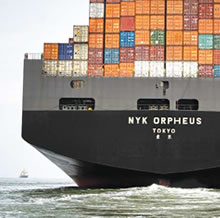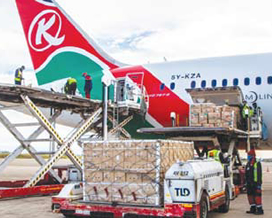 Intercontinental ocean shipping of agricultural products is considered more carbon and cost efficient and may provide more flexibility compared to air freight. The Kenyan government is actively supporting sea freight so that Kenya remains competitive in the global market. Although sea transport is already common practice for some Kenyan fruit (avocado, pineapple), for flower export, this option is still poorly explored.
Intercontinental ocean shipping of agricultural products is considered more carbon and cost efficient and may provide more flexibility compared to air freight. The Kenyan government is actively supporting sea freight so that Kenya remains competitive in the global market. Although sea transport is already common practice for some Kenyan fruit (avocado, pineapple), for flower export, this option is still poorly explored.
Kenya exports a significant amount of products to the Netherlands, most of which are related to agriculture. Globally the main mode of transport for trade is ocean shipping, this is however not the case for Kenya. Most of it is transported by air as this is a quicker form of transportation. For agricultural products with a short shelf life such as flowers, fruits and vegetables this is especially important. In 2020 however, COVID-19 exposed the limitations of airfreight in Kenya. Passenger flights carry freight in the belly of the plane and due to a high number of flights being cancelled there was a huge shortfall of airfreight capacity. By increasing maritime shipping, Kenya can provide an alternative way of transporting goods, decrease costs and reduce its environmental footprint.
There are several arguments to choose for sea transportation over air transportation. Sea shipments considerably reduce transportation cost (to about 50% compared to air transportation) and provide much more flexibility and satisfy the need for increased transportation capacity especially during holidays (Valentine’s day, mother’s day). It has been shown in several recent investigations that the transportation of roses in refrigerated (reefer) containers is possible.
However, sea transportation has not yet become common practice in the transport of roses from Kenya to The Netherlands. A major challenge in sea transport are the long transport times (30-35 days) to reach the major destinations in Europe. Without proper treatments, roses may not survive the trip in good quality.
 Good results for sea freight shipment are seen for avocados, pineapples and flowers. The primary fresh product shipped by sea from Kenya is avocados, representing around 3,000 containers per year.
Good results for sea freight shipment are seen for avocados, pineapples and flowers. The primary fresh product shipped by sea from Kenya is avocados, representing around 3,000 containers per year.
“The shipment of flowers by sea is steadily increasing, but was still only around 100 containers in 2020. If 20% of airfreight was transferred by sea this would result in over 100+ containers a week. To achieve this potential it was suggested by several interviewees that the Kenyan industry sets objectives, for instance to ship 50% by 2030 of the 2020 export volumes.”
Sea freight opens up the opportunity of new markets for Kenya. Bigger capacity and more competitive freight costs would increase sales to the Middle East or Far East, i.e. Singapore and China. Future national investments in sea freight would safeguard and potentially increase existing employment in the fresh produce and cut flower sector in Kenya. Furthermore, sea freight compared to airfreight could cut emissions by 85%.
Bottlenecks in the chain
The outcome of rose shipments over sea is, therefore, variable and often disappointing. After arrival in Europe, roses should be able to withstand a 3-4 day period in the retail channel and should have a remaining vase life at the consumer of at least 7 days of acceptable quality. Main problems that are invoked by the long transport time are failure of flower opening, leaf desiccation and fungal infections.
The elucidation of the reasons for the variability in flower quality at arrival is complicated by a multitude of factors. There are many different rose cultivars used in the shipments and they come from a variety of growers. On top of this, different postharvest treatments and protocols are applied. Together this makes it hard to pin point the main bottlenecks in the chain.
In 2021 a pilot experiment was executed with financial support from the Netherlands Ministry of Agriculture, Nature and Food Quality. The experiment involved a number of Dutch flower traders and technical and logistical service providers to get more insight in failure and success factors for sea freight.
Treatment of the rose during pilot
After harvest, flowers received treatments at the farm, including a pre-treatment to block effects of ethylene.The flower buds were dipped in a solution to suppress fungal (botrytis) development. They were packed in boxes and transported by truck to Nairobi, where they were vacuum cooled and loaded into a reefer that was trucked to Mombasa. Thereafter, the container was shipped to Rotterdam. Conditions in the reefer were set to 0.5°C, 4% CO2 and 4% O2. Loggers were inserted in boxes to monitor conditions. Including a slight delay at the customs at arrival the total trip took 35 days. At arrival flowers were rehydrated and received a retail and vase life simulation.
Factors that contribute to the sea freight variability
As for the issue of flower failure and leafdesiccation, the consortium organized a pilot shipment consisting of different rose cultivars sourced from different growers in the Naivasha region. As much as possible all postharvest factors (pre-treatments, anti-fungal dip, temperature management, vacuum cooling and conditions in the reefer) were held similar for all the flowers. This set-up allowed for comparison of the performance of different cultivars and to investigate the contribution of “grower” to the outcome.
One of the main focus points was Leaf Quality and vase life. There was a big variability between different cultivars in relation to vase life.Independent of the grower, some always performed better than other cultivars. The same was true for flower opening and the vase life.
This shows that both cultivar and grower have a significant impact on the final quality of the roses after the shipment.
Recommendations
To achieve the full potential of Kenyan agriculture and for it to remain competitive, the sea freight industry requires a boost. Sea freight of agricultural exports has to become more efficient with more reliable and direct shipments to Western Europe and costs need to be brought down. The industry, together with the government of Kenya, will have to set an ambition for a certain proportion of products to be sent by sea by 2030. To achieve this, an enabling environment will need to be created by the government of Kenya and the other parties involved. This not only asks for a complete overhaul of Mombasa port with sufficient berths, good management and practices suitable for perishable goods, but also an optimal network of consolidation centers to support the further growth of avocado and other exports. From Page 7 Cover Story
Courtesy: Netherlands Embassy.


